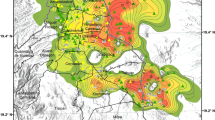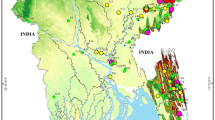Abstract
This study aimed to analyze earthquake disaster risk based on the Bener Meriah-Aceh map in Indonesia, specifically focusing on the event that occurred on July 2, 2013, measuring 6.2 on Richter scale with a significant impact on both society and the environment. The method used was Geographic Information System (GIS), a technique for disaster analysis. Earthquake disaster map which was produced by referencing the Indonesian law for disaster map standard (Perka BNPB 2/2012) was analyzed using an overlay of three components, namely, hazard, vulnerability, and capacity. Furthermore, the generation of earthquake hazard map involved the collection of some data, such as the SNI earthquake map (Indonesia National Standard), the length of an active fault, ten years of MMI (Modified Mercalli Intensity) map, fault density, and geomorphology and geology maps. Vulnerability earthquake map was obtained by analyzing the physical, economic, and social hazard data, while capacity map was calculated using the indicator in the Hyogo Framework for Actions. The results showed that 122 people were exposed to the low-level earthquake risk, with 37,768 belonging to the threatened vulnerable group, leading to physical-economic losses of IDR 368 billion (Indonesian Rupiah). In the medium category, 1869 people were exposed, and 48,809 were potentially vulnerable, resulting in physical-economic losses of IDR 718 billion. Perka BNPB 2/2012 states that the exposed victims were directly impacted in the risk area (low-medium–high). The vulnerable group comprises children under 5, the elderly, people with disabilities, and individuals living in poverty within the analyzed districts. Therefore, earthquake disaster risk analysis for the Bener Meriah district yielded two categories, namely, medium and low.












Similar content being viewed by others
Data Availability
The data used in this study is proprietary in nature and cannot be made available.
References
Abdelkarim B, Telahigue F, Agoubi B (2022) (2022) Assessing and delineation of groundwater recharge areas in coastal arid area southern Tunisia. Groundw Sustain Dev 18:100760. https://doi.org/10.1016/j.gsd.2022.100760
Abdelkarim B, Telahigue F, Abaab N, Boudabra B, Agoubi B (2023) AHP and GIS for assessment of groundwater suitability for irrigation purpose in coastal-arid zone: Gabes region, southeastern Tunisia. Environ Sci Pollut Res 30:15422–15437. https://doi.org/10.1007/s11356-022-23193-4
Agoubi B, Kharroubi A (2019) Groundwater depth monitoring and short-term prediction: applied to El Hamma aquifer system, southeastern Tunisia. Arab J Geosci 12:324. https://doi.org/10.1007/s12517-019-4490-1
Anshori RM, Samodra G, Mardiatno D, Sartohadi J (2022) Volunteered geographic information mobile application for participatory landslide inventory map**. Comput Geosci 161. https://doi.org/10.1016/j.cageo.2022.105073
BNPB (2012) Peraturan Kepala Badan Nasional Penanggulangan Bencana Nomor 02 Tahun 2012 Tentang Pedoman Umum Pengkajian Risiko Bencana [Perka BNPB 2/2012: Regulation of the Head of the National Disaster Management Agency Number 02 of 2012 About General Guidelines for Disaster Risk Assessment]. Indonesian. Accessed 10 August 2022. https://bnpb.go.id/uploads/migration/pubs/30.pdf
Chang-chun L, Guang-sheng Z, Tian-jie L, A-du G (2011) Quick image-processing method of UAV without control points data in earthquake disaster area. Trans Nonferrous Met Soc China 21:s523–s528
Ezzelarab M, Shokry MMF, Mohamed AME, Mohamed AA, El-Hadidy MS (2016) Evaluation of seismic hazard at the northwestern part of Egypt. J Afr Earth Sc 113:114–125
Farhan A, Akhyar H (2017) Analysis of tsunami disaster map by geographic information system (GIS): Aceh Singkil-Indonesia”, IOP Conf. Series: Earth and Environmental Science 56:1–13
Fariza A, Rusydi I, Hasim JAN, Basofi A (2017) Spatial flood risk map** in east Java, Indonesia, using analytic hierarchy process - natural breaks classification, 2nd International conferences on Information Technology, Information Systems and Electrical Engineering (ICITISEE). Yogyakarta 2017:406–411
Feng X, Xu** C, Aizhu R, **nzheng L (2008) Earthquake disaster simulation for an urban area, with GIS, CAD, FEA, and VR integration. Tsinghua Sci Technol 13(S1):311–316
Gaspar-Escribano JM, Rivas-Medina A, Parra H, Cabañas L, Benitoa B, Barajas SR, Solares JMM (2015) Uncertainty assessment for the seismic hazard map of Spain. Eng Geol 199:62–73
Gu E, Meng T, Wang H, Zhang A (2023) E-government use, perceived transparency, public knowledge of government performance, and satisfaction with government: an analysis of mediating, moderating, and framing mechanisms based on the COVID-19 outbreak control survey data from China. Soc Indic Res 169:79–124. https://doi.org/10.1007/s11205-023-03135-4
Gupta K, Satyam N (2022) Estimation of Arias intensity and peak ground acceleration (PGA) using probabilistic seismic hazard assessment of Uttarakhand state (India). Arab J Geosci 15:437. https://doi.org/10.1007/s12517-022-09733-9
Halvorson SJ, Hamilton JP (2010) In the aftermath of the Qa’yamat:1 the Kashmir earthquake disaster in northern Pakistan. Disasters 34(1):184–204
Hegazi AM, El-Rayes AE, Arnous MO, Al-Moazamy AA (2023) Revealing the geomorphic parameters of neotectonics based on geological and seismic data at Wadi Beda basin, NW Gulf of Suez. Egypt Arab J Geosci 16:82. https://doi.org/10.1007/s12517-022-11165-4
Hutchings SJ, Mooney WD (2021) The seismicity of indonesia and tectonic implications. Geochem Geophysics Geosyst 22(9):1–42. https://doi.org/10.1029/2021GC009812
Jena R, Pradhan B, Beydoun G et al (2020) Seismic hazard and risk assessment: a review of state-of-the-art traditional and GIS models. Arab J Geosci 13:50. https://doi.org/10.1007/s12517-019-5012-x
Kimura R, Inoguchi M, Tamura K, Hayashi H (2015) Comparison between the life recovery processes after the Mid-Niigata Earthquake and the Chuetsu-Oki Earthquake-Results of a random sampled social survey using the life recovery calendar and GIS-based spatiotemporal analysis. J Disaster Res 10(2):196–203
Missaoui R, Abdelkarim B, Ncibi K, Hamed Y, Choura A, Essalami L (2022) Assessment of groundwater vulnerability to nitrate contamination using an improved model in the Regueb Basin. Cent Tunis Water Air Soil Pollut 233:320. https://doi.org/10.1007/s11270-022-05806-3
Missaoui R, Ncibi K, Abdelkarim B, Bouajila A, Choura A, Hamdi M, Hamed Y (2023) (2023) Assessment of hydrogeochemical characteristics of groundwater: link of AHP and PCA methods using a GIS approach in a semi-arid region. Cent Tunis Euro-Mediterr J Environ Integr 8:99–114. https://doi.org/10.1007/s41207-023-00345-7
Pailoplee S (2012) Relationship between Modified Mercalli Intensity and peak ground acceleration in Myanmar. Nat Sci 4:624–630. https://doi.org/10.4236/ns.2012.428082
Rahman N, Ansary MA, Islam I (2015) GIS based map** of vulnerability to earthquakeand fire hazard in Dhaka city, Bangladesh. Int J Disaster Risk Reduction 13:291–300
Rürup and Charlin A (2017) Strengthening capacities for the use of GIS in disaster risk reduction, thesis student Division of Risk Management and Societal Safety, Lund University
Sun C, Chun S, Ha T, Chung C, Kim D (2008) Development and application of a GIS-based tool for earthquake-induced hazard prediction. Comput Geotech 35(3):436–449. https://doi.org/10.1016/j.compgeo.2007.08.001. (ISSN 0266-352X)
Uitto JI (1998) The geography of disaster vulnerability in megacities: a theoretical framework. Appl Geogr 18(1):7–16
Urakawa G (2016) Building a GIS-based information system with seamless interaction between operations and disaster management - new challenges of Kitakyushu Fukuoka in Using Spatial Information for Regional Disaster Resilient Societies. J Disaster Res 11(5):897–910
Wardhana BAS, Hafizh I, Arsyi H, Faridsyah WA, Marom N (2023) Exploring the overlooked seurula potential in Arun field; a preliminary study from outcrops and subsurface data in North Sumatra Basin. Proceedings, Indonesian Petroleum Association, Forty-Seventh Annual Convention & Exhibition, July 2023
Yanto, Apriyono A, Santoso PB, Sumiyanto (2022) Landslide susceptible areas identification using IDW and Ordinary Kriging interpolation techniques from hard soil depth at middle western Central Java, Indonesia. Nat Hazards 110:1405–1416. https://doi.org/10.1007/s11069-021-04982-5
Ye M, Wang J, Huang J, Xu S, Chen Z (2012) Methodology and its application for community-scale evacuation planning against earthquake disaster. Nat Hazards 61:881–889
Yeh H-F, Hsu H-L (2019) Using the Markov chain to analyze precipitation and groundwater drought characteristics and linkage with atmospheric circulation. Sustainability 11(6):1817. https://doi.org/10.3390/su11061817
Zook M, Graham M, Shelton T, Gorman S (2010) Volunteered geographic information and crowdsourcing disaster relief: a case study of the Haitian Earthquake. World Med Health Policy 2(2):7–33
Author information
Authors and Affiliations
Corresponding author
Ethics declarations
Conflict of interest
The author(s) declare that they have no competing interests.
Additional information
Responsible Editor: Longjun Dong
Rights and permissions
Springer Nature or its licensor (e.g. a society or other partner) holds exclusive rights to this article under a publishing agreement with the author(s) or other rightsholder(s); author self-archiving of the accepted manuscript version of this article is solely governed by the terms of such publishing agreement and applicable law.
About this article
Cite this article
Farhan, A., Nasution, A.I. & Akhyar Earthquake disaster map using GIS analysis: a case study of Bener Meriah-Aceh, Indonesia. Arab J Geosci 17, 53 (2024). https://doi.org/10.1007/s12517-023-11850-y
Received:
Accepted:
Published:
DOI: https://doi.org/10.1007/s12517-023-11850-y




